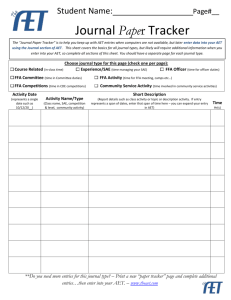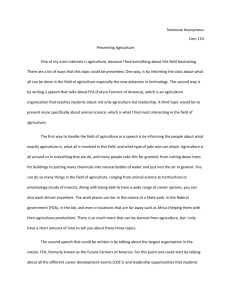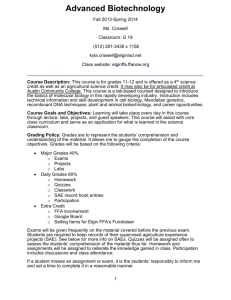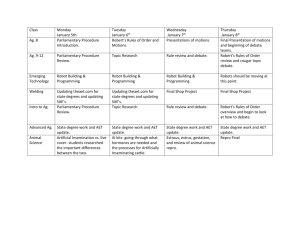Document 14193760
advertisement
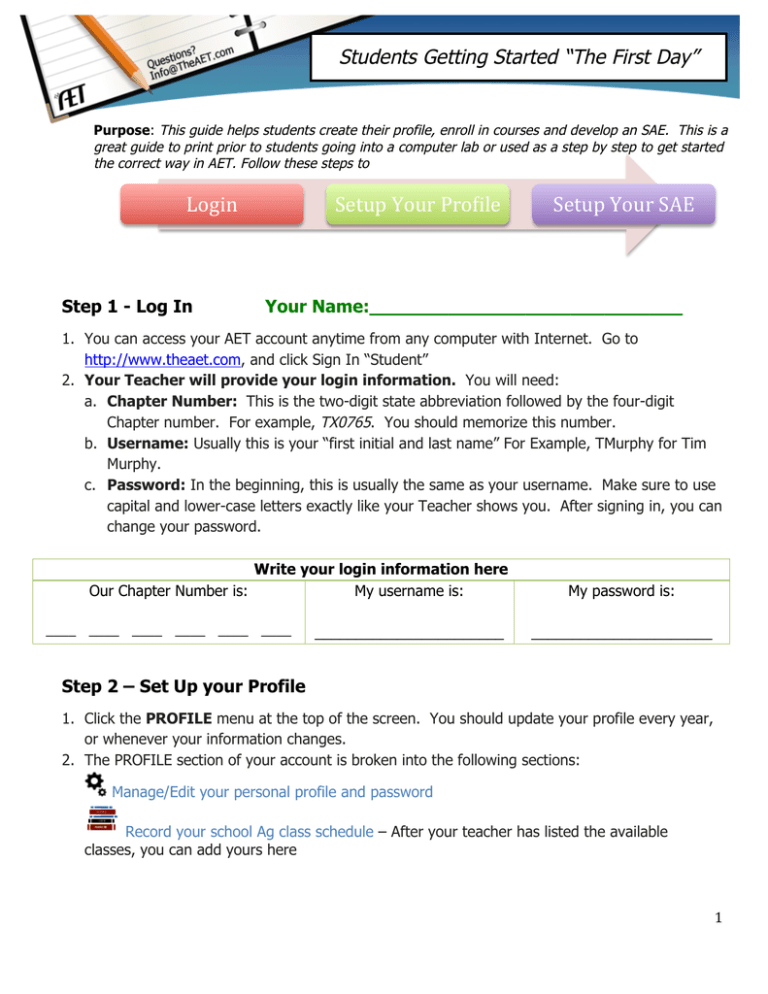
Students Getting Started “The First Day” Purpose: This guide helps students create their profile, enroll in courses and develop an SAE. This is a great guide to print prior to students going into a computer lab or used as a step by step to get started the correct way in AET. Follow these steps to Login Step 1 - Log In Setup Your Pro0ile Setup Your SAE Your Name:____________________________ 1. You can access your AET account anytime from any computer with Internet. Go to http://www.theaet.com, and click Sign In “Student” 2. Your Teacher will provide your login information. You will need: a. Chapter Number: This is the two-digit state abbreviation followed by the four-digit Chapter number. For example, TX0765. You should memorize this number. b. Username: Usually this is your “first initial and last name” For Example, TMurphy for Tim Murphy. c. Password: In the beginning, this is usually the same as your username. Make sure to use capital and lower-case letters exactly like your Teacher shows you. After signing in, you can change your password. Write your login information here Our Chapter Number is: My username is: ____ ____ ____ ____ ____ ____ _______________________ My password is: ______________________ Step 2 – Set Up your Profile 1. Click the PROFILE menu at the top of the screen. You should update your profile every year, or whenever your information changes. 2. The PROFILE section of your account is broken into the following sections: Manage/Edit your personal profile and password Record your school Ag class schedule – After your teacher has listed the available classes, you can add yours here 1 Develop your Resume – A very basic outline of your accomplishments that should be updated each year to report involvement. Maintain your list of school and or community activities, special certifications, skills, and awards. Develop your AET Experiences - This is your project(s) in agriculture education. Unless you are very familiar with AET and the project, skip this section and review step 3 and look at the guide “Selecting an SAE and Creating the Experience” Enter your FFA offices – If you are an FFA Officer, add your office here. Enter your FFA committee memberships - If you are on an FFA Committee, add it here. Choose your agricultural career pathway - Check the box next to the Ag Careers that interest you, rank them on the right side. Explore your educational and career interests – Find and select the careers of interest Step 3 – You are done with your PROFILE, but here are some ideas to begin your SAE An SAE is a Supervised Agricultural Experience. It’s just another name for a project that you do outside regular class with the help of your teacher or another supervisor. See “Developing an Experience” Guide in AET for more details on types of SAEs A. NOW…Brainstorm some SAEs that describe an SAE for you…a project that is outside of class where you learning something new…try to create three ideas: I am interested in….(A) I am interested in…(B) I am interested in…(C) Now pick one and get some more details 2 There are four primary types of SAEs: (CHECK ONES THAT FIT YOUR INTEREST) • ____/A, B, C Exploratory - Learn about something in agriculture and its many related careers. • ____/A, B, C Research/Experimental - Conduct research and analyze information to discover new knowledge. • ____/A, B, C Ownership/Entrepreneurship - Plan and operate an agriculture-related business. • ____/A, B, C Placement - Work for a business or individual, either for pay or for the experience. The following further describes you project, so select the area that describes your projects: (CHECK ONE THAT DESCRIBES YOUR INTEREST) • ___/A, B, C Agribusiness Systems —the study of business principles, including management, marketing and finance, and their application to enterprises engaged in Agriculture, Food and Natural Resources • ___/A, B, C Animal Systems —the study of animal systems, including life processes, health, nutrition, genetics, management and processing, through the study of small animals, aquaculture, livestock, dairy, horses and/or poultry • ___/A, B, C Biotechnology Systems —the study of data and techniques of applied science for the solution of problems concerning living organisms • ___/A, B, C Environmental Service Systems —the study of systems, instruments and technology used in waste management and their influence on the environment • ___/A, B, C Food Products and Processing Systems —the study of product development, quality assurance, food safety, production, sales and service, regulation and compliance, and food service within the food science industry • ___/A, B, C Natural Resource Systems —the study of the management of soil, water, wildlife, forests and air as natural resources • ___/A, B, C Plant Systems —the study of plant life cycles, classifications, functions, structures, reproduction, media and nutrients, as well as growth and cultural practices, through the study of crops, turf grass, trees and shrubs and/or ornamental plants • ___/A, B, C Power, Structural and Technical Systems —the study of agricultural equipment, power systems, alternative fuel sources and precision technology, as well as woodworking, metalworking, welding and project planning for agricultural structures • ___/A, B, C Career Cluster Skills - Study of general agriculture education area, leadership, personal growth and career success skills necessary for a chosen profession while effectively contributing to society. Ideas: Have students complete this guide and turn it in for a grade, then enter into AET 3
